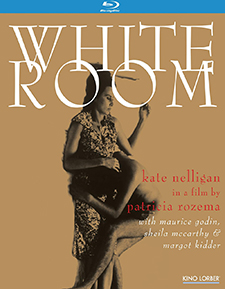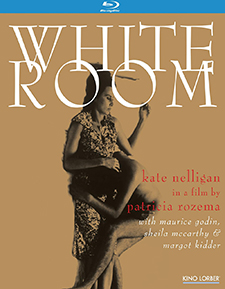White Room (Blu-ray Review)

Director
Patricia RozemaRelease Date(s)
1990 (June 25, 2024)Studio(s)
Vos Productions Inc. (Kino Lorber)- Film/Program Grade: C+
- Video Grade: A
- Audio Grade: A
- Extras Grade: B
Review
Some films are very good at using assorted cinematic techniques to create a dreamlike atmosphere. White Room abounds with gauzy effects and visual metaphors, and features an elusive central character. The performances, the director’s choices, and the mysterious images grab you from the outset and keep you involved.
Norm (Maurice Godin, Boat Trip) is a young man who fancies himself an author suffering writer’s block. He lives with his parents and rides around on his bicycle late at night to peep at women in their homes for inspiration. On one of his ogling excursions, he witnesses the murder of rock star Madelaine X (Margot Kidder, Sisters). He races to a phone booth and calls the police, but feels guilty for not crashing in to help her during the attack and for keeping his call to the police anonymous. So he tells his parents that he’s leaving their upscale suburban home for gritty San Francisco, where he will be able to write book.
To support himself until he becomes a successful author, he needs a job. He soon encounters Zelda (Sheila McCarthy, Pacific Heights), a quirky young woman who gives him a job manning her news stand, and they become friends. Then Norm catches a glimpse of Jane (Kate Nelligan, Eye of the Needle) and recognizes her as the woman in black weeping quietly on the fringe of Madelaine X’s funeral. Intrigued, he follows her all the way to her crumbling country house. She discovers him snooping and, flustered, he claims to want work as her gardener. She hires him. Her reclusiveness makes him want to get closer to her; gardening for her seems a possible entry into her private life.
Jane is extremely fragile and shuns visitors, so it takes some time before she fully trusts Norm. Eventually, however, they form a bond and fall in love. Norm subsequently discovers an unsettling secret about the connection between Madeleine and Jane. Now, instigated by Zelda and her visions of dollar signs, he feels inspired and writes a draft of the true story and its consequences.
Writer/director Patricia Rozema has given White Room a leisurely pace that enhances the picture’s dream-like quality. Images often interrupt other images to suggest Norm’s state of mind. The scenes of Norm prowling at night in the wooded areas around homes suggest that he might be up to something sinister, but he’s just a lonely, harmless person who seeks excitement in others’ lives because his is so bland. Director Rozema shoots many scenes through windows, giving us the sensation that we’re sharing Norm’s voyeurism. In fact, the opening scenes could easily have set the scene for a horror film about a crazed, homicidal stalker. But the film goes in an entirely different direction, somewhat like Alfred Hitchcock’s Rear Window.
Nelligan has hardly any dialogue for most of the film and relies upon expressions and reactions to frame her performance. Garbo-like in a large hat, sunglasses, and dark clothes, she moves stealthily and quickly, never lingering to attract curious eyes. But there’s more. Nelligan conveys a sadness and vulnerability. Her Jane has withdrawn from the world and wishes to live apart from the rest of humanity. Director Rozema uses several well-placed close-ups of Nelligan to show gradual changes in Jane’s demeanor as the story unfolds.
Godin seems an odd choice for Norm. He’s fine as the loner turned on by simply looking into windows for some kind of gratification. When Norm witnesses the murder, however, Godin’s performance is unconvincing. Wide-eyed and stone-faced, he’s frozen as he watches the mayhem through perfectly positioned window blinds. Yes, part of this is Norm’s character, but there’s a subtlety needed here that Godin seems incapable of conveying. He comes off better with his scenes with Nelligan, and there’s definite chemistry between the two. But why is he wearing a puffy pirate shirt for nearly half the film? It’s tough to accept him as leading man because he comes off as such a goof.
McCarthy plays Zelda with the right touch of self-assured, cartoonish bossiness. Zelda is a brash, opportunist who fancies herself an artist and sees in exposing Jane a way to achieve fame, however fleeting. Her attire is part thrift store, part self-expression, and part dumpster. After Norm sets out on his own, the only women he comes in contact with are Zelda and Jane, complete opposites. One is loud, talky, and streetwise, the other is like a delicate bird, sequestered from the world’s realities.
Margot Kidder plays Madelaine X. The role is so small, it barely makes an impression, and that’s a shame. It would have been interesting—perhaps in flashback—to see her character in concert. Kidder is such an interesting actress, it’s a pity she’s underused.
Director Rozema deals with several themes in White Room—the search for artistic inspiration, the pitfalls of pop culture, the meaning of love, and misplaced adulation, to name a few. She’s very good at taking us through a story that assumes the look of a fairy tale. This isn’t the modern world but an ethereal version, the kind you would find in a storybook. Rozema employs memorable images, such as fireworks superimposed on the pupil of an eye, a cup overflowing with blood, soft focus images, and numerous superimpositions. She shows us Norm’s recurring dream of falling backward and disappearing into a huge vat of milk. Rozema may not be the best director out there, but she’s consistently interesting. For all its good points, however, there’s a level of detachment in the way the story unfolds that distances and alienates the viewer.
White Room was shot by director of photography Paul Sarossy on 35 mm film with spherical lenses and presented in the aspect ratio of 1.85:1. Kino Lorber’s Blu-ray features a new 4K restoration of the film, made possible by Telefilm Canada. Clarity and contrast are excellent. There are many double exposures throughout to highlight the film’s dreamy quality. A key set is the stark monochromatic room of the film’s title, with not only walls, ceiling and floor, but also recording equipment, chairs, monitors and tapes pure white. The scenes in Jane’s garden are lush, with vibrant green the dominant hue. The color palette is fairly bright, and a few scenes are shot from a low angle to reveal a bright blue sky. Jane’s dark dress stands out from the otherwise cheery tones.
There are three soundtrack options: English 5.1 and 2.0 DTS-HD Master Audio, and French 2.0 DTS-HD Master Audio. Optional subtitles include English and French. Dialogue is clear and distinct. Mark Korven’s score, in keeping with the style of the film, has a light, elegant quality. The songs, based on poems by Emily Dickinson, defy traditional genres and have a techno New Age quality, once again suggesting we are in a world other than our own.
Bonus materials on the Blu-ray release from Kino Lorber include the following:
- Audio Commentary by Patricia Rozema
- Behind-the-Scenes Image Gallery (1:35)
- This Might Be Good (7:02)
- Archival Interview with Patricia Rozema (4:45)
- Mouthpiece Re-Release Trailer (1:53)
- When Night Is Falling Re-Release Trailer (1:32)
- White Room Re-Release Trailer (1:31)
Audio Commentary – The film opens with the image of the white room—pure, quiet, still. Director Patricia Rozema likes to incorporate metaphors for meaning. She saw the film as the boundary between desire to see others when they don’t know they’re being watched and their right to privacy. She started to feel a fascination with celebrity. The songs were written by Rozema and Mark Korven based on poems by Emily Dickinson. To be interesting in movies, male characters must be active, generous and protective. Norm has none of these qualities, but is empathetic. Rozerma talks about her early career as a journalist and then an artist, noting that there’s a power struggle between them. An edgy reality appeals to Norm. Zelda is “as shallow as a bird bath.” Margot Kidder had a public struggle with issues similar to those of the character she plays. A celebrity complaining about celebrity is the least interesting topic for an audience. Rozema, speaking about the responsibility of a director to an audience, is happiest making movies when she’s able to project yearning. She tries not to worry about being modern. There are as many agendas for movies as there are movies. Is Norman following Jane, or is it a “mutual dance”? The week White Room was released, there was a scandal about Milli Vanilli getting credit for work they didn’t do. Rozema talks about the genesis of White Room. It started as the story of Zelda, who was written differently from the version in White Room. When Norm was added as Zelda’s friend, he took over center stage with his struggles against his bourgeois origins and wishes for extremes. In terms of the film’s cinematography, she says, “There is something inherently thrilling about looking through windows.”
Behind-the-Scenes Image Gallery – Color and black & white still photographs from White Room are shown in slideshow format.
This Might Be Good – In this 2000 black & white short film by Patricia Rozema, a young woman looks into a mirror and readies herself for an event. We later see her on stage in front of an audience being introduced as the actress in the film about to be shown. Intercut with these images is the projectionist getting the film ready to show. As the film is shown, the actress joins the projectionist and they watch the film together. Later, members of the audience join the two viewers in the projection booth to continue watching from that vantage point. The film has no dialogue, features multiple dissolves, and contains dramatic music.
Archival Interview with Patricia Rozema – Rozema says, “The white room is a place of ultimate clarity.” Kate Nelligan offers her thoughts about the director and the role of Jane. The screenplay appealed to her because it was a tender love story. Nelligan enjoyed working with Rozema, who set a pleasant tone on the set. Jane lives from inside herself. Godin got the part because he was very expressive in his audition.
White Room is a mixture of genres, seamlessly blending elements of fairytale, romantic drama, noir and avant garden stylization. While the film is certainly intriguing, it never fully engages the viewer. Perhaps it’s because the characters are intentionally metaphorical. The use of Emily Dickinson as a source of song lyrics might be a bit pretentious. Nelligan is a strong screen presence who keeps us involved but Godin, her co-star, is unconvincing. It’s unlikely that a stronger leading man would have made the film any more than a visually interesting experiment in story telling.
- Dennis Seuling

